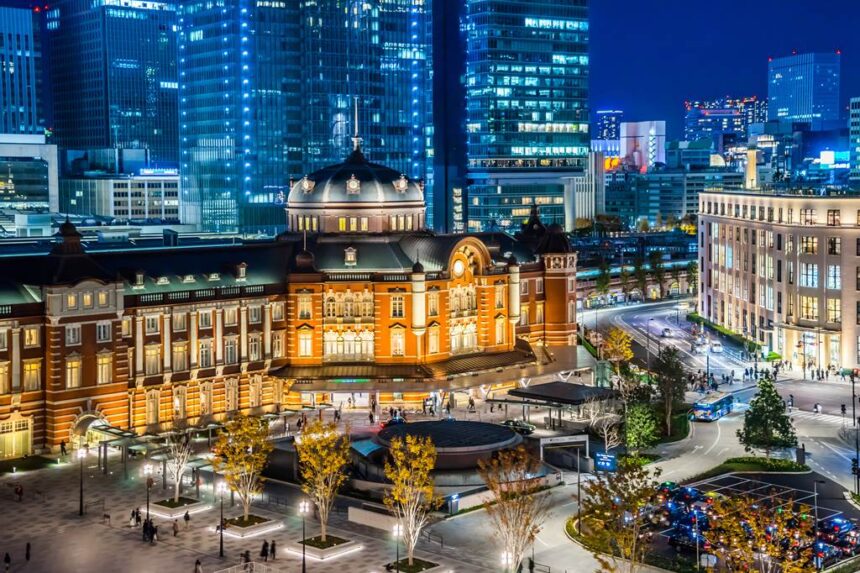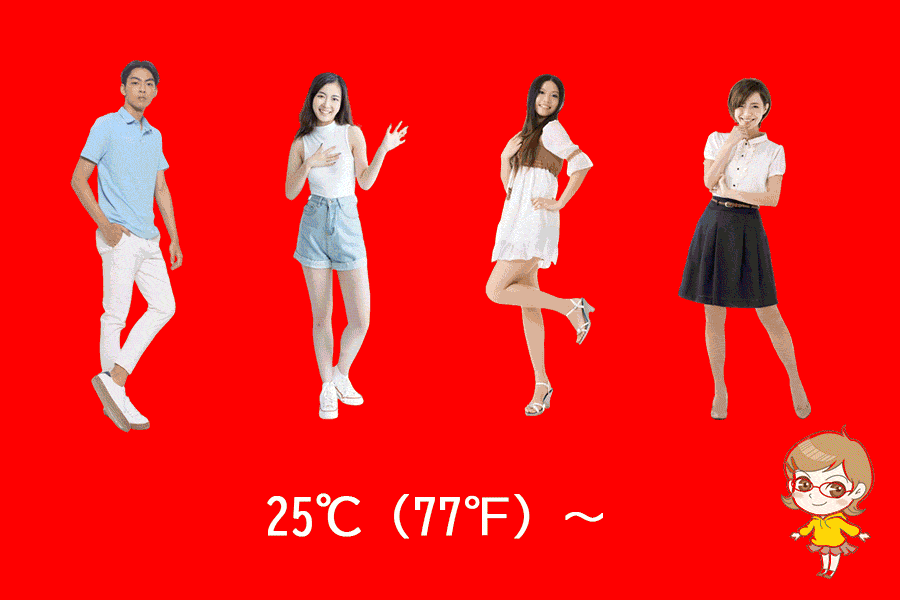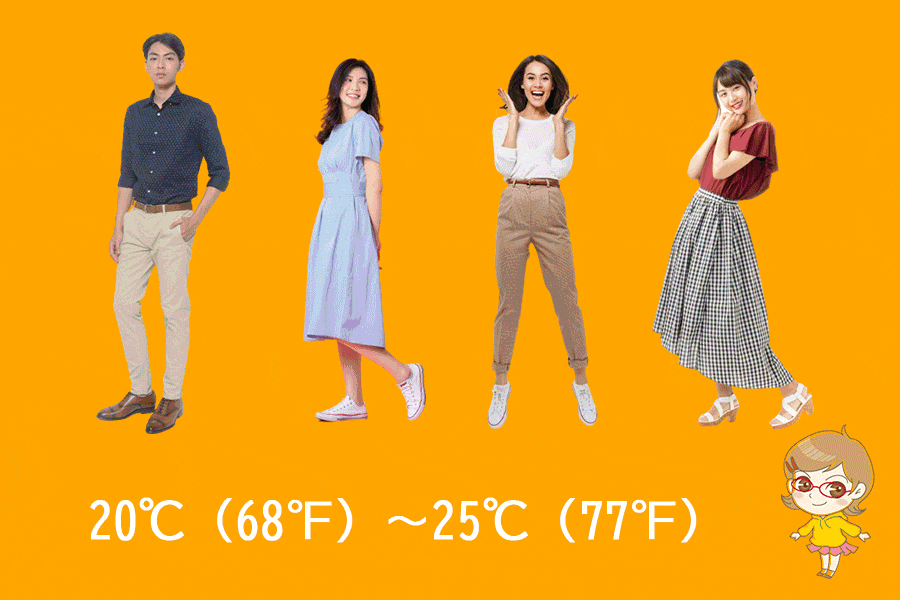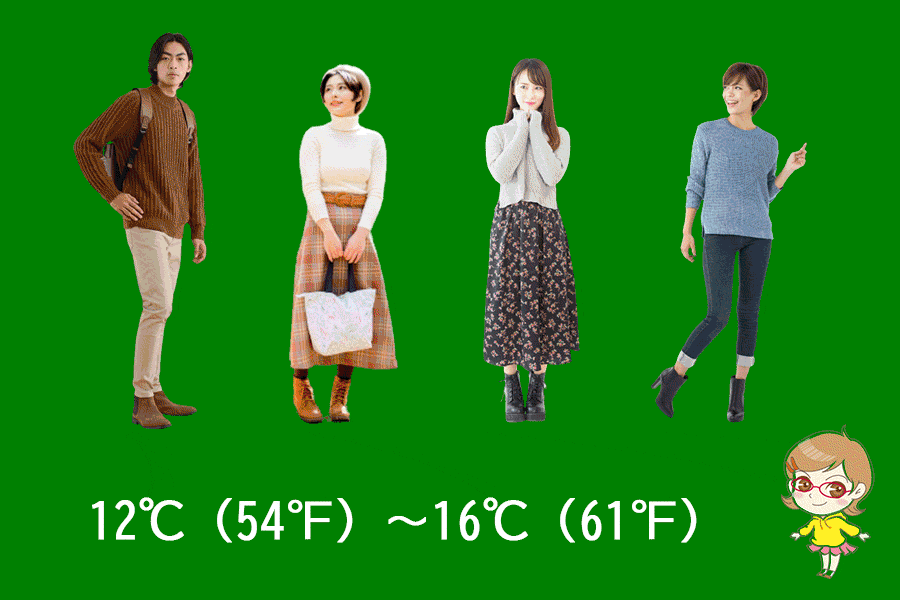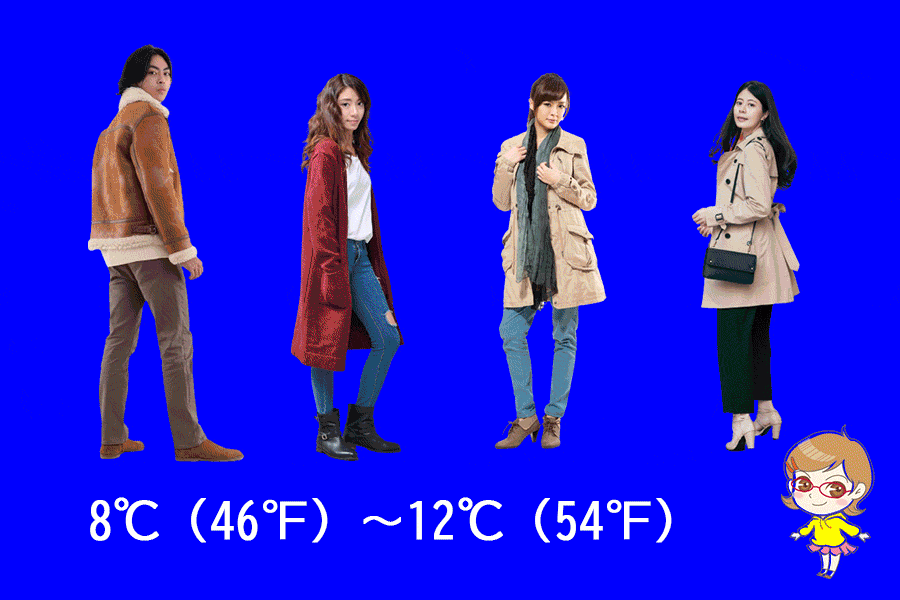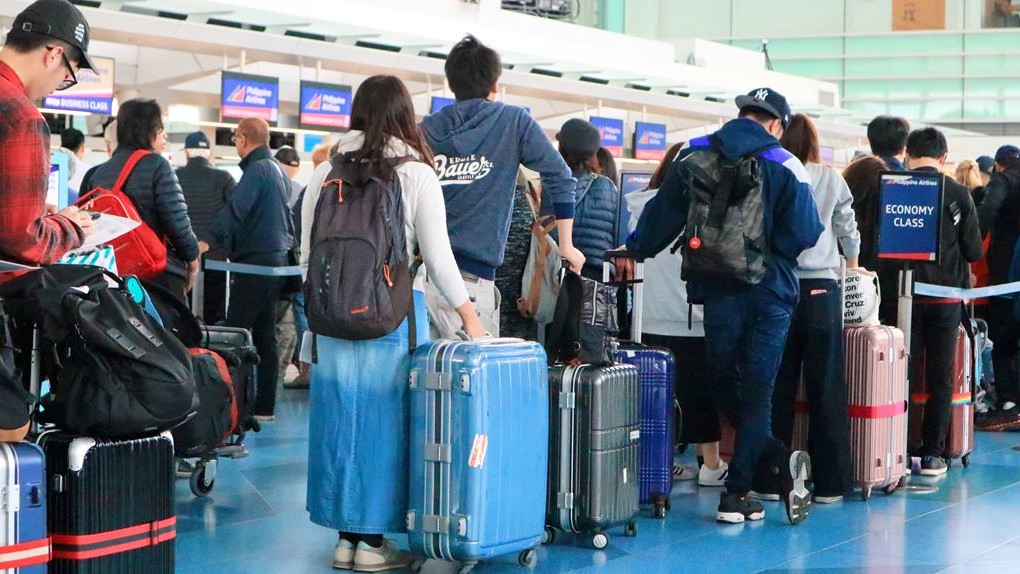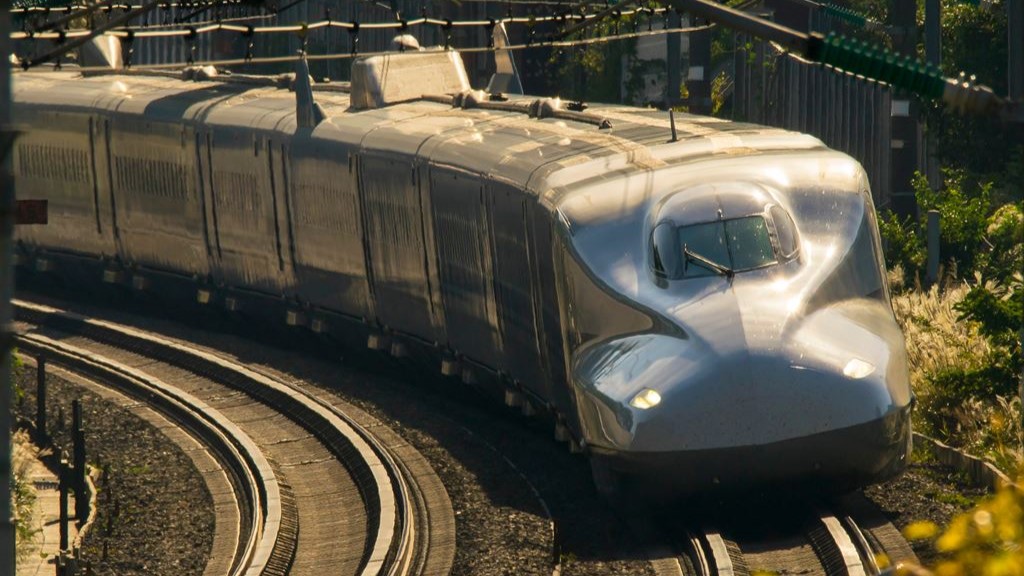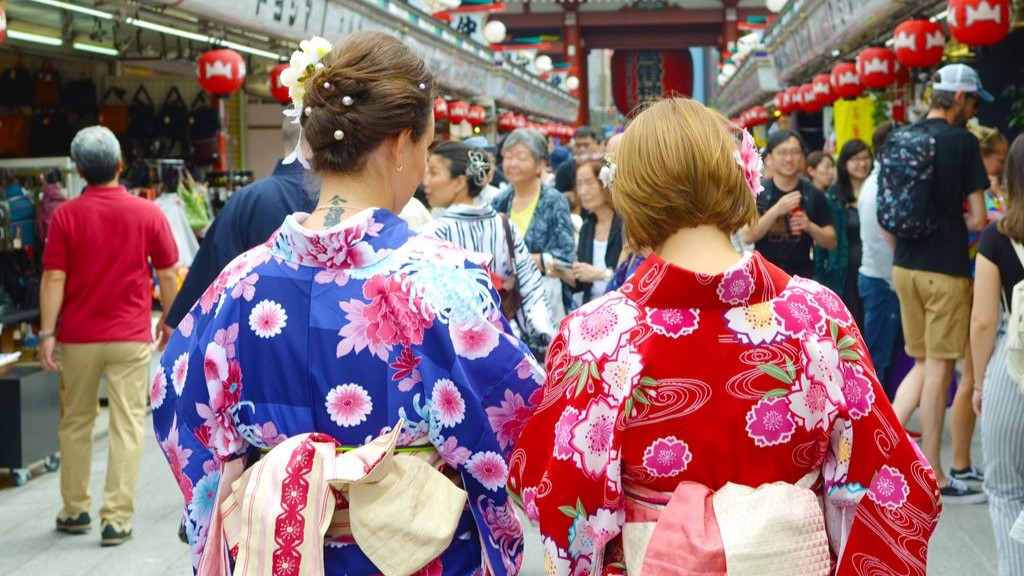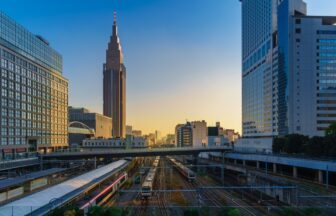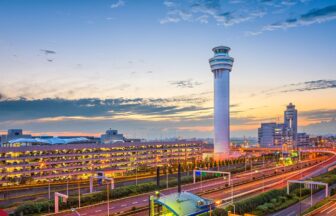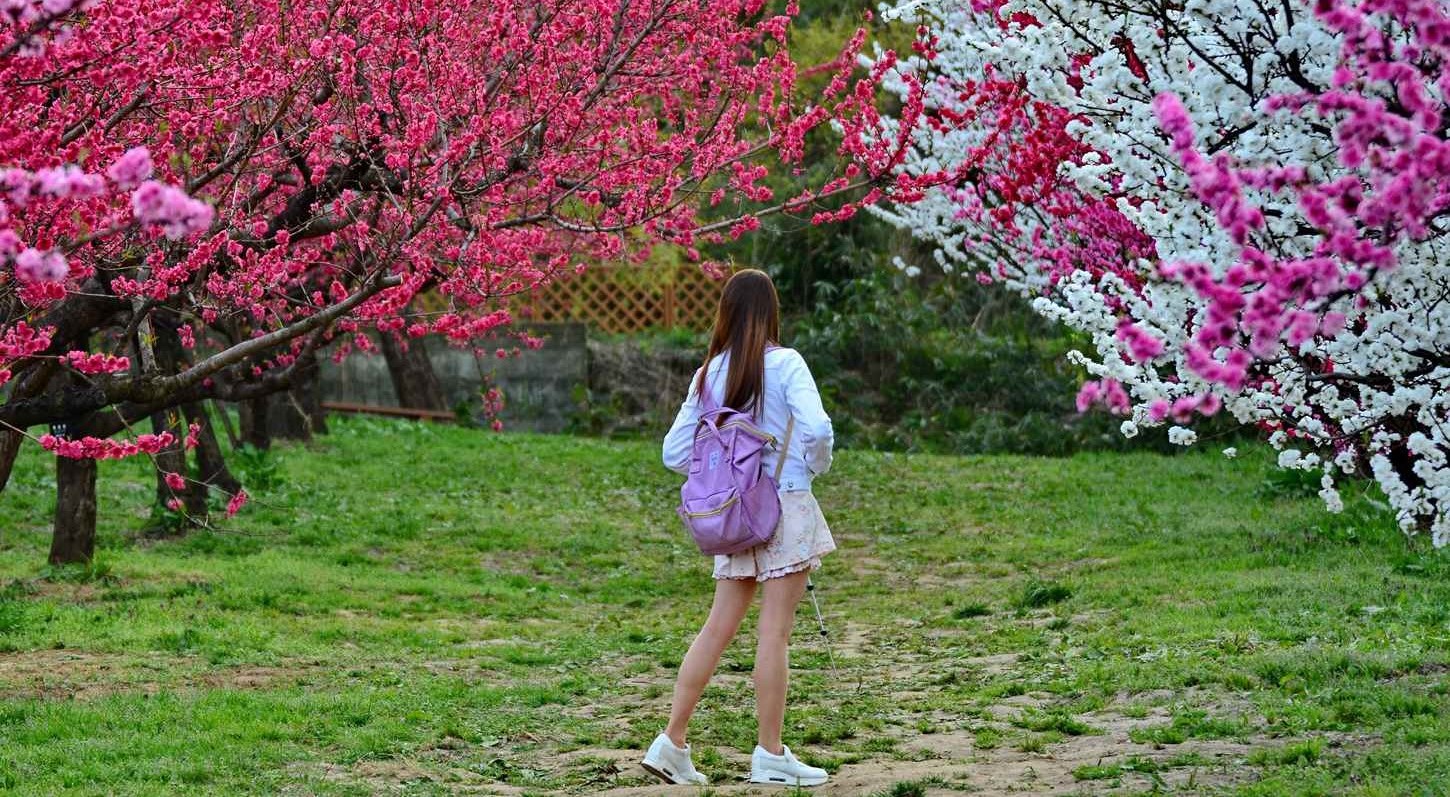1 Chome Marunouchi, Chiyoda City, Tokyo 100-0005 MAP
↓ Click to jump to the relevant section.
| Current Weather | Annual Weather | Tourist Attractions |
| Baggage Deposit | Hotels |
Current weather and clothing

The weather information shown here is the information closest to the station in question. Please note that there may be slight differences.
Yearly temperature changes and recommended clothing
Clothing recommendations for each temperature range
When traveling in Japan with the following average temperatures, the recommended clothing is as follows:
Monthly changes in temperature, precipitation, and snowfall (1991~2020 average, Japan Meteorological Agency survey)
| Jan. | Feb. | Mar. | Apr. | May | Jun. | Jul. | Aug. | Sep. | Oct. | Nov. | Dec. | |
| temperature(°C) | 5.4 | 6.1 | 9.4 | 14.3 | 18.8 | 21.9 | 25.7 | 26.9 | 23.3 | 18 | 12.5 | 7.7 |
| precipitation(mm) | 59.7 | 56.5 | 116 | 133.7 | 139.7 | 167.8 | 156.2 | 154.7 | 224.9 | 234.8 | 96.3 | 57.9 |
| snowfall(cm) | 4 | 4 | 0 | — | — | — | — | — | — | — | — | 0 |
Winter
December
The average temperature in December is around 7.7 degrees Celsius. The air is dry and the average precipitation is around 50 mm. It is quite cold, so it is advisable to bring warm clothing such as a heavy coat, sweater, and hat. Scarves and gloves are also recommended. Thick pants and boots will also be useful for walking around town.
January
January in Tokyo is one of the coldest months of the year, with an average temperature of 5.4°C. The weather is generally dry, with only 59.7 mm of precipitation on average for the month. However, the temperature can feel colder due to the wind, and it’s not uncommon to have days with sub-zero temperatures. Therefore, wearing warm clothing is essential for staying comfortable during this time. Men and women are advised to dress in layers, starting with thermal underwear, followed by a long-sleeved shirt, sweater, and a warm coat. It is also important to wear a hat, gloves, and a scarf to protect your head, hands, and neck from the cold. Additionally, waterproof and slip-resistant shoes are recommended to prevent slipping on icy pavements.
February
February in Tokyo is also cold, with an average temperature of 6.1°C. The weather is dry and sunny with only 59.7 mm of precipitation on average. Like January, it’s important to dress in layers to stay warm, starting with thermal underwear, a long-sleeved shirt, sweater, and a warm coat. A hat, gloves, and a scarf are also necessary to protect your head, hands, and neck from the cold. Waterproof and slip-resistant shoes are recommended to prevent slipping on icy pavements.
Spring
March
In March, the weather starts to warm up in Tokyo, with an average temperature of 9.4°C. However, it can still be quite chilly, especially in the evenings, and it’s important to wear warm clothing. The weather is generally dry and sunny, with only 116 mm of precipitation on average. Men and women are advised to wear a combination of warm and light clothing, such as a long-sleeved shirt, a sweater or light jacket, and a warm coat. Waterproof and slip-resistant shoes are still recommended.
April
April is a transitional month in Tokyo, with temperatures rising to an average of 14.3°C. It is a relatively dry month with only 133.7 mm of precipitation on average, and the weather is often sunny. It is important to dress in light layers as the temperature can fluctuate throughout the day. Men and women can wear a light jacket or sweater over a long-sleeved shirt, with comfortable pants or jeans. It’s advisable to wear comfortable walking shoes as there is a lot of walking to be done in Tokyo.
May
In May, the temperature continues to rise in Tokyo, with an average of 18.8°C. The weather is usually sunny, with an average precipitation of 139.7 mm. It is advisable to wear light and comfortable clothing, such as a light T-shirt or blouse with comfortable pants or shorts. It is also important to bring a light jacket or cardigan as the evenings can still be cool. Comfortable walking shoes are still recommended.
Summer
June
June is the start of the rainy season in Tokyo, with an average temperature of 22.9°C. It is the wettest month of the year, with an average precipitation of 167.8 mm. It is important to wear light and breathable clothing that dries quickly, such as a light T-shirt or blouse and shorts or light pants. It is also advisable to bring a light waterproof jacket or raincoat, as well as an umbrella. Comfortable walking shoes are still recommended.
July
In July, Tokyo experiences its warmest temperatures of the year. The average temperature is around 25.7°C. Visitors should prepare for occasional thunderstorms and showers throughout the month. Therefore, it is recommended to wear lightweight clothing, such as shorts, skirts, and T-shirts, made of breathable materials like cotton or linen. It is also a good idea to bring a lightweight raincoat or umbrella.
August
August is another hot and humid month in Tokyo. The average temperature in August is around 26.9°C. The humidity can make it feel much hotter. While there is slightly less rainfall than in July, it is still a wet month, with an average of 154.7 mm of rain. It is recommended to wear lightweight and breathable clothing, such as shorts, dresses, and lightweight T-shirts. Sunscreen and a hat are also recommended to protect against the strong UV rays.
Autumn
September
September marks the beginning of autumn in Tokyo, with temperatures starting to cool down from the highs of summer. The average temperature in September is around 23.3°C. While the temperatures can still be warm during the day, the evenings can start to feel cooler. Typhoons often pass through the Japanese archipelago in September. As a result, precipitation is relatively heavy even in Tokyo, with an average precipitation of 224.9 mm. It is recommended to wear lightweight clothing such as T-shirts, light pants or skirts, and a light jacket or sweater for the cooler evenings.
October
October is another pleasant month in Tokyo, with comfortable temperatures and clear skies. The average temperature is around 18°C. The weather is typically dry, with an average of 234.8 mm of rain. It is recommended to wear long-sleeved shirts, light sweaters, and a light jacket for cooler evenings. It is also advisable to bring a light raincoat or umbrella, as occasional rain is possible.
November
In November, temperatures continue to drop, and it becomes increasingly chilly in Tokyo. The average temperature is around 12.5°C. While it is a drier month than August and September, with an average of 96.3 mm of rainfall, occasional rain is still possible. In addition, it can snow occasionally in Tokyo during November, so it is recommended to wear warm clothing, such as a sweater, jacket, and a coat. Long pants and closed-toe shoes are also recommended. Gloves, a scarf, and a hat will be necessary if it snows.
Recommended tourist destinations
Senso-ji Temple
2-3-1, Asakusa, Taito 111-0032 Tokyo Prefecture
The oldest temple in Tokyo with a history of nearly 1,400 years. The “Nakamise Street” leading to the temple is also the oldest shopping street, with nearly 90 stores selling souvenirs and food.The Kaminarimon (Thunder Gate), located at the entrance to the approach to the temple, is a landmark of Asakusa.
Tokyo Tower
4-chome 2-8, Shibakoen, Minato 105-0011 Tokyo Prefecture
The 333-meter radio tower was completed in 1958. With a 150-meter-high main deck, a 250-meter-high top deck, and two observation decks, visitors can enjoy a powerful view of Metropolis Tokyo.
Imperial Palace
1-1 Chiyoda, Chiyoda 100-0001 Tokyo Prefecture
Edo Castle, the former residence of the Tokugawa Shogunate, became the Imperial Palace in 1868. Surrounding the castle are gardens open to the public and the remains of Edo Castle. The New Year’s General Visit, held every year on January 2 to celebrate the New Year, is the only opportunity for the general public to enter the Imperial Palace and express their congratulations to the Imperial Family, and attracts many people from Japan and abroad.
Kabukiza Theater
4-12-15, Ginza, Chuo 104-0061 Tokyo Prefecture
A theater specializing in Kabuki opened in 1889. The current building was rebuilt in 2013. The plaza in the basement sells a wide variety of souvenirs, including sundries and famous confections that express the world of Kabuki.
Tokyo Skytree
1 Chome-1-2, Oshiage, Sumida 131-8634 Tokyo Prefecture
At 634 meters, it is the world’s tallest freestanding radio tower. Visitors can enjoy a walk in the air in the observation corridor 450 meters above the ground. At the foot of the tower are commercial facilities, a planetarium, and an aquarium, which are always crowded with tourists.
Ueno Park
Uenokoen, Taito 110-0007 Tokyo Prefecture
In the vast 53-hectare park, a variety of flowers and trees, including cherry blossoms, add color to the seasons. In addition to the Ueno Zoo, there are many cultural facilities within the park, including the Tokyo National Museum and the National Museum of Nature and Science. The Ueno Zoo is home to giant pandas, which are extremely popular.
Akihabara
Sotokanda, Chiyoda 101-0021 Tokyo Prefecture
Akihabara developed as Japan’s largest electronics town after World War II, and has since become a mecca for Japanese manga and anime culture, with a number of game and anime-related stores. Maid cafes, where store clerks greet customers in maid costumes, are also popular.
Tsukiji Jogai Market
4-16-2, Tsukiji, Chuo 104-0045 Tokyo Prefecture
The Tsukiji Market functioned as the kitchen of Tokyo until 2018. Even after the main market was relocated to Toyosu, some 400 specialty stores are still in operation. In addition to fresh fish, meat, and vegetables, the market also offers a wide variety of cooking tools and tableware such as knives, as well as sushi and ramen restaurants.
Tsukiji Hongwanji Temple
3-15-1, Tsukiji, Chuo 104-8435 Tokyo Prefecture
The exterior of the temple is modeled after ancient Buddhist architecture from India and other Asian countries, giving it an oriental atmosphere. The main hall and gateposts are designated as national important cultural properties. The temple also has a store, tea lounge, and café, and is popular among tourists as a temple that is open to the public.
Hama Rikyu Gardens
1-1 Hamarikyu Teien, Chuo 104-0046 Tokyo Prefecture
A representative Daimyo garden of the Edo period. There is a tidal pond that brings in seawater from Tokyo Bay, and the scenery changes with the ebb and flow of the tide.
In the early 2000s, the surrounding area was redeveloped and the Shiodome skyscrapers stand in contrast to the garden.
Where to leave your luggage
There are a total of 43 coin lockers at Tokyo Station: 13 inside the ticket gates and 30 outside the ticket gates.
Information centers are located in the “Central Passage” in the center of the Tokyo Station premises, and information can be obtained there.
In addition to coin lockers, there is also a “Luggage Service Counter” outside the Yaesu South Exit ticket gate, where you can leave your luggage from 9:30 to 20:00.
Recommended hotels and inns
The Tokyo Station Hotel
1-9-1, Marunouchi, Chiyoda 100-0005 Tokyo Prefecture
1-minute walk from Tokyo Central Railway Station
Hotel class: 4
Hotel style: Centrally Located , Family
Check Rates & Availability:
>> See on Tripadvisor
>> See on Trip.com
>> See on Expedia
Marunouchi Hotel
1-6-3, Marunouchi, Chiyoda 100-0005 Tokyo Prefecture
3-minutes walk from Tokyo Central Railway Station
Hotel class: 4
Hotel style: Business
Check Rates & Availability:
>> See on Tripadvisor
>> See on Trip.com
>> See on Expedia
HOTEL METROPOLITAN TOKYO MARUNOUCHI
1-7-12, Marunouchi, Chiyoda 100-0005 Tokyo Prefecture
5-minutes walk from Tokyo Central Railway Station
Hotel class: 4
Hotel style: Centrally Located , Business
Check Rates & Availability:
>> See on Tripadvisor
>> See on Trip.com
>> See on Expedia
Shangri-La Tokyo
1-8-3 Marunouchi Trust Tower Main, Marunouchi, Chiyoda 100-8283 Tokyo Prefecture
5-minutes walk from Tokyo Central Railway Station
Hotel class: 5
Hotel style: Centrally Located , Great View
Check Rates & Availability:
>> See on Tripadvisor
>> See on Trip.com
>> See on Expedia
Four Seasons Hotel Tokyo at Marunouchi
1-11-1 Pacific Century Place, Marunouchi, Chiyoda 100-6277 Tokyo Prefecture
6-minutes walk from Tokyo Central Railway Station
Hotel class: 5
Hotel style: Family , Business
Check Rates & Availability:
>> See on Tripadvisor
>> See on Trip.com
>> See on Expedia
Hotel Ryumeikan Tokyo
1-3-22, Yaesu, Chuo 103-0028 Tokyo Prefecture
7-minutes walk from Tokyo Central Railway Station
Hotel class: 3
Hotel style: Modern , Centrally Located
Check Rates & Availability:
>> See on Tripadvisor
>> See on Trip.com
>> See on Expedia
Palace Hotel Tokyo
1-1-1, Marunouchi, Chiyoda 100-0005 Tokyo Prefecture
7-minutes walk from Tokyo Central Railway Station
Hotel class: 5
Hotel style: Great View , City View
Check Rates & Availability:
>> See on Tripadvisor
>> See on Trip.com
>> See on Expedia
HOSHINOYA Tokyo
1-9-1, Otemachi, Chiyoda 100-0004 Tokyo Prefecture
9-minutes walk from Tokyo Central Railway Station
Hotel class: 5
Hotel style: Charming , Centrally Located
Check Rates & Availability:
>> See on Tripadvisor
>> See on Trip.com
>> See on Expedia
Mandarin Oriental Tokyo
2-1-1 Nihonbashi Muromachi, Chuo 103-8328 Tokyo Prefecture
12-minutes walk from Tokyo Central Railway Station
Hotel class: 5
Hotel style: Great View , Family
Check Rates & Availability:
>> See on Tripadvisor
>> See on Trip.com
>> See on Expedia
Imperial Hotel Tokyo
1-1-1 Uchisaiwaicho, Chiyoda 100-8558 Tokyo Prefecture
16-minutes walk from Tokyo Central Railway Station
Hotel class: 3
Hotel style: Classic , Centrally Located
Check Rates & Availability:
>> See on Tripadvisor
>> See on Trip.com
>> See on Expedia
We support your itinerary planning!
Click the button to get an overview of hotel information and popular tourist routes from all over Japan featured on our site. We’ve included comprehensive details to aid in planning your trip, so please make use of it.
Comprehensive checklist before traveling to Japan
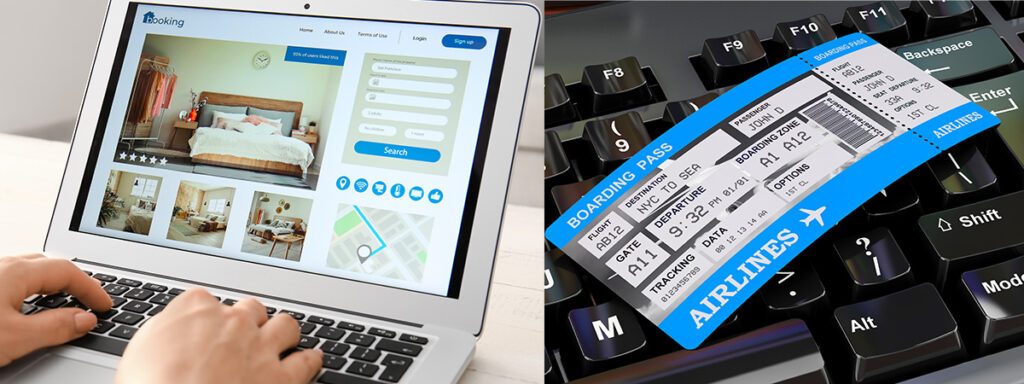
Book flights
Compare and purchase flight tickets
When planning your trip to Japan, it's advisable to start by researching flights several months in advance. Airlines often release promotional fares, especially during off-peak seasons. Use comparison sites like Skyscanner or KAYAK to get a sense of the price range. Be flexible with your travel dates if possible; flying mid-week might be cheaper than on weekends.
>> Visit Skyscanner's official website
>> Visit KAYAK's official website
Order Japan Rail Passes for each family member
Purchase your Japan Rail Pass before departure
The Japan Rail (JR) Pass offers unlimited travel on JR trains, making it a cost-effective option for tourists. However, it's only available to foreign tourists and must be purchased *before* you arrive in Japan. Determine the areas you plan to visit; if you're traveling extensively, a nationwide pass is beneficial, but if you're only exploring a specific region, consider regional JR passes. Children under 12 get a discounted pass, so ensure you order the correct type for each family member.
>>Visit Japan Rail Pass's website
Plan your attire for Japan
Check the weather at your destination on this site
Japanese weather varies significantly by season. In summer, it's hot and humid, so breathable clothes are essential. Winters, especially in the north, can be cold, requiring warm attire. If visiting during the rainy season (June to early July), pack a good umbrella and waterproof shoes. While Japan is generally casual, certain places like temples, shrines, or upscale restaurants may require modest and neat dressing.
Reserve a pocket Wi-Fi or SIM card

SIM card or pocket Wi-Fi is required
Beyond clothes, consider packing essentials like a universal power adapter (Japan uses Type A and B sockets), portable Wi-Fi or SIM card for internet access, and any necessary medications (with a copy of the prescription).
Which is better: a SIM card or pocket Wi-Fi?
When traveling in Japan, one essential to consider is securing internet access, especially given that many locations still don't offer free Wi-Fi. To ensure you can use your smartphone throughout your trip, you'll typically have three options: (1) a SIM card, (2) pocket Wi-Fi, or (3) the roaming service provided by your mobile company. Roaming services can be quite expensive, so we often recommend using a SIM card or pocket Wi-Fi. While SIM cards tend to be more affordable than pocket Wi-Fi, they can be trickier to set up. Pocket Wi-Fi, on the other hand, can be shared among several users, making it a favorable choice for families or groups.
▼SIM card
Advantages:
Relatively affordable.
Disadvantages:
Can be time-consuming to set up initially.
May have strict data limits.
▼Pocket Wi-Fi
Advantages:
Offers substantial data allowances.
A single device can be shared among multiple users.
Easily usable with PCs as well.
Disadvantages:
Typically more expensive.
Japan's representative services
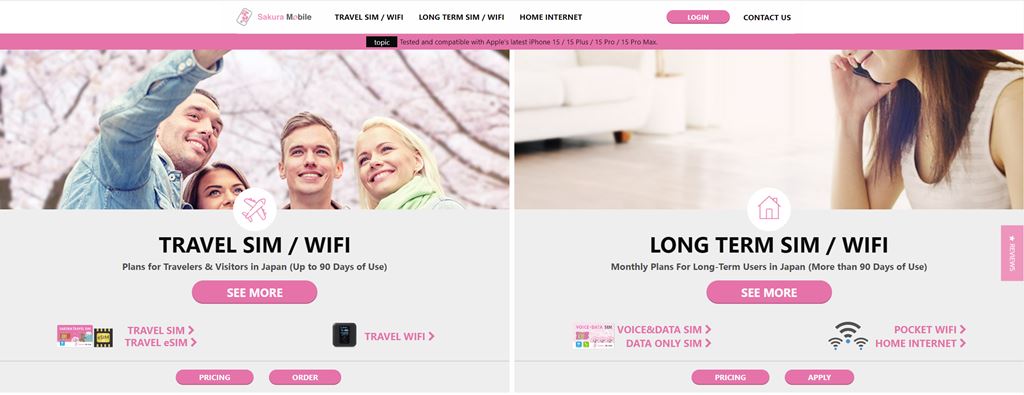
Sakura Mobile's website
▼SIM card
>>Visit Sakura Mobile's official website
>>Visit mobal's official website
▼pocket Wi-Fi
>>Visit Sakura Mobile's official website
>>Visit NINJA WiFi's official website
>>Visit Wi-Fi RENTAL Store's official website
Book local tours as needed
Pre-book your tour and have a great trip!
Local tours offer deep insights into Japan's culture and heritage. Websites like Viator or GetYourGuide offer a variety of tours, from traditional tea ceremonies to modern pop culture tours in Akihabara. Consider unique experiences like staying with monks on Mt. Koya or taking a cooking class to learn authentic Japanese dishes.
>>Visit Viator's official website
>>Visit GetYourGuide's official website
Purchase advance tickets for popular attractions
Make a reservation to avoid crowds
Attractions like Tokyo Disneyland, Universal Studios Japan, or the Studio Ghibli Museum often have long ticket queues. Buy tickets online in advance to save time. Some attractions also have timed entry, so check the specific time slots available and plan accordingly.
▼Tokyo Disney Resort
>>Visit Tokyo Disney Resort official website
>>Visit Viator's Tokyo Disneyland page
>>Visit Viator's Tokyo DisneySea page
>>Visit GetYourGuide's Tokyo Disneyland page
>>Visit GetYourGuide's Tokyo DisneySea page
▼Universal Studios Japan
>>Visit USJ official website
>>Visit Viator's USJ page
>>Visit GetYourGuide's USJ page
Buy travel insurance

insurance concept, health, life and travel insurance
It is important to be prepared for emergencies
While Japan is a safe country, travel insurance is crucial for unforeseen events like health emergencies, travel disruptions, or lost baggage. Ensure your policy covers medical expenses in Japan, as healthcare, though excellent, can be expensive.
Here we introduce online travel insurance services that are popular worldwide.
World Nomads: An online travel insurance service widely endorsed by travelers worldwide. They offer plans that cover adventurous activities and high-risk sports.
>>Visit World Nomads' official website
AIG Travel Guard: An insurance service available to travelers all over the world. They offer a wide range of options, including cancellation protection and emergency medical insurance.
>>Visit AIG Travel Guard's official website
Share your itinerary with emergency contacts
Organize your reservation information
Keep a digital and printed copy of your detailed itinerary, including hotel addresses, train schedules, and booked tours. Share this with a trusted family member or friend not traveling with you.

